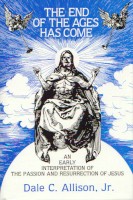|
|
Classic Reprints and Out-of-Print |
|
Reprint Spotlight: The Life of Jesus Jesus'
Proclamation of
- Select new &
used Contact Information:
More detailed information may be found in the Order Information section. |
The
End of the Ages Has Come:
An Early Interpretation of the Passion and
Resurrection of Jesus
by Dale C. Allison, Jr.
 |
List Price: Cloth - 194 pp |
|
Allison takes a long, careful look at the different uses made of the notion of an eschatological tribulation in both intertestamental Judaism and the New Testament. Of equal importance, he places the discussion of the New Testament's realized eschatology within its wider context -- the problem of promise and fulfillment in messianic movements throughout history: "The eschatological prophecies of Jesus were believed to have met their initial fulfillment in the Messiah's death and resurrection. This had dawned the great Day of the Lord." |
|
|
|
